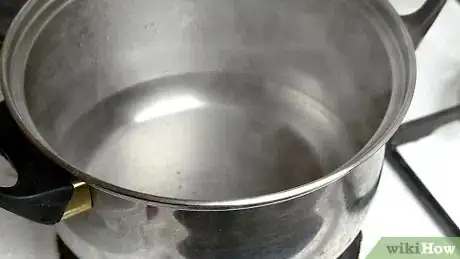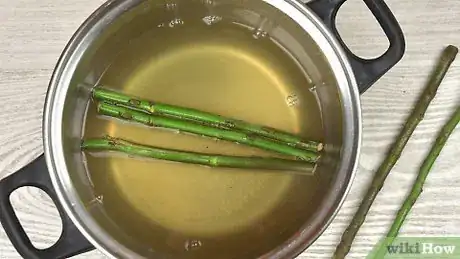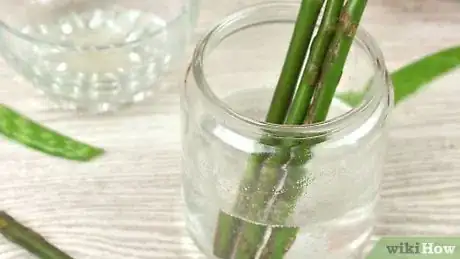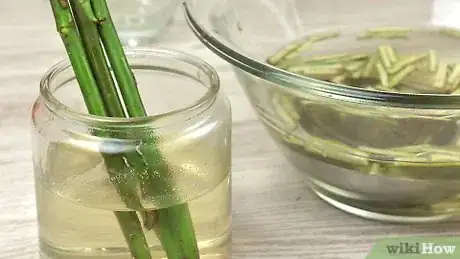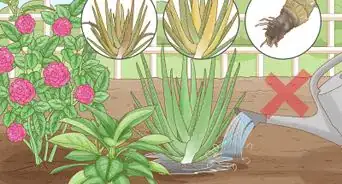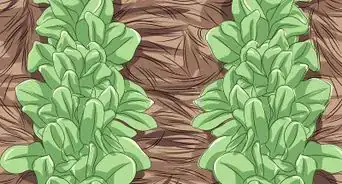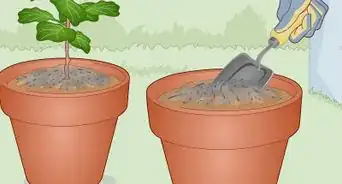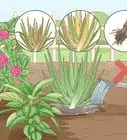This article was co-authored by wikiHow staff writer, Hunter Rising. Hunter Rising is a wikiHow Staff Writer based in Los Angeles. He has more than three years of experience writing for and working with wikiHow. Hunter holds a BFA in Entertainment Design from the University of Wisconsin - Stout and a Minor in English Writing.
There are 8 references cited in this article, which can be found at the bottom of the page.
The wikiHow Video Team also followed the article's instructions and verified that they work.
This article has been viewed 263,587 times.
Learn more...
Rooting hormones help plant cuttings grow better and form strong root systems. While you can buy many rooting powders or tonics from gardening stores, you can make your own using things you may have around your home. Using honey or aloe will help prevent bacteria and fungi from forming on new growths, while aspirin or willow branches will provide growth hormones so roots develop faster.
Steps
Mixing a Honey Rooting Tonic
-
1Boil 2 c (470 ml) of water before reducing the heat. Fill a pot with tap water and put it on your stove over high heat. Let the water heat up completely until it comes to a rolling boil. Turn the heat to low to let the water simmer before moving on.
- You can also use purified or filtered water if you’re worried about any foreign substances in your tap water.
-
2Stir in 2 US tbsp (30 ml) of honey and let the solution cool. Use standard honey from a grocery store for your rooting hormone. Scoop the honey directly into the pot of simmering water and use a mixing spoon to stir it together. As soon as the honey dissolves completely in the water, turn off the heat and let the pot cool completely.[1]
- Honey contains antibacterial, antiseptic, and antifungal properties as well as promotes healthy root growth.
Tip: Put a lid on the pot while it cools to prevent anything from contaminating the solution.
Advertisement -
3Soak plant cuttings in the honey solution for 2-3 hours before planting them. Once the rooting hormone is completely cooled, put the cuttings in the pot so the bottom 1–2 inches (2.5–5.1 cm) are submerged. Let the cuttings soak for at least 2-3 hours before putting them in a growing medium so they can absorb the solution.[2]
- You can also dip the end of your cutting in honey before planting it in the ground for an additional layer of protection from fungus and bacteria.
Using Aloe Vera as a Rooting Hormone
-
1Push the gel out from an aloe vera leaf using a spoon. Cut a healthy leaf off an aloe plant with a clean, sharp knife. Lay the leaf flat on a cutting board in front of you so the pointed end faces you. Press the back of a spoon on the point of the leaf and apply firm pressure as you guide the spoon toward the cut end. The gel from inside the leaf will push out of the cut end onto your cutting board.[3]
- The aloe gel protects the cutting from bacteria and fungi in the soil.
- You may also use aloe gel from stores as long as it doesn't have any other added ingredients.
-
2Mash the gel in a cup until it has a watery consistency. Scoop the gel from the aloe leaf into a small cup and stir it with your spoon to break apart the larger pieces. Use the back of your spoon to smash the gel to loosen its consistency so it’s runnier. Once the gel easily moves around and flows like water, you can use it for your hormone.[4]
- Add 1 tablespoon (15 ml) of water to your aloe gel if you can't mash it to the right consistency.
-
3Coat the bottom of your cutting in the aloe gel before you plant it. When you’re ready to plant your cuttings, dip the cut ends into the aloe gel. Spin the cutting around so you get an even coating of the gel on the stem before putting it in your soil. The aloe gel on the cut end will help prevent any bacteria or fungi from entering the stem.[5]
Making Rooting Hormone with Aspirin
-
1Crush an uncoated aspirin pill into a fine powder. Use a standard 325-mg aspirin tablet that doesn’t have any form of coating around it. Put 1 aspirin tablet inside of a pill crusher and screw the top on. Apply firm pressure to the top of the pill crusher to break the pill apart inside. Continue crushing the pill until it forms a fine powder.[6]
- You can buy pill crushers from your local pharmacy.
- Aspirin contains salicylic acid as an active ingredient, which helps prevent bacteria or fungus from forming on your cutting so it can develop roots.
Variation: If you don’t have a pill crusher, you can also put the aspirin in a resealable plastic bag and break the pill apart with a hammer.
-
2Mix the ground aspirin with 1 c (240 ml) of distilled water. Fill a glass or jar with 1 cup (240 ml) of distilled water and pour the aspirin powder into it. Use a spoon to stir the powder into the water until it completely dissolves. If some of the chunks don’t dissolve right away, then let the solution sit for about 1 hour before stirring and checking on it again.
- You can also put an uncrushed aspirin pill in the water rather than the powder, but it will take longer for it to dissolve.
- You may use tap water, but the aspirin may not dissolve as well.
-
3Dip your cuttings in the aspirin solution for 2-3 hours before you plant them. Take your fresh cuttings and submerge at least 1 inch (2.5 cm) of their bottom ends. Let the cuttings absorb the aspirin solution for about 2-3 hours so they remain healthy after you plant them.[7]
Brewing a Willow Water Solution
-
1Collect 2 cups (256 g) of young branches from a willow tree. Collect the branches in spring when new growths are forming on the tree. Look for fresh green shoots and branches that are skinnier than a pencil to use for your rooting tonic. Use a pair or pruning shears or a sharp utility knife to cut the willow branches at a 45-degree angle so the tree doesn’t develop rot.[8]
- You can use any type of willow for your rooting hormone.
- Don’t use any dead branches since they won’t contain any of the natural rooting hormones.
Variation: You may also collect the bark from established willows if you’re able. If you use bark, collect 3 cups (384 g) instead since it contains fewer hormones.
-
2Cut the branches into 1 in (2.5 cm) pieces. Use a sharp knife or a pair of pruning shears to cut the branches to a smaller size. Make sure each section of branch is about 1 inch (2.5 cm) long so they can easily submerge them later on.[9]
- Willows contain salicylic and indole butyric acids, which are natural growth hormones that will help your cutting quickly form roots once you plant it.
- Cut bark pieces to the same size if you used them instead of branches.
-
3Add the willow pieces to boiling water and let them soak for 24 hours. Bring 1 gallon (3.8 L) or water to boil over high heat on your stove. As soon as the water comes to a rolling boil, turn off the heat and pour in the willow branches so they can soak. Put a lid on the pot and leave the branches inside for 24 hours. During that time, the hormones will extract from the branches and mix with the water.
- Adjust the recipe if you don’t want to make as much rooting hormone, but keep a ratio of 2 cups (256 g) of willow pieces to 1 gallon (3.8 L) of water.
-
4Pour the liquid from the pot into glass containers with lids. After the solution cools, carefully transfer the solution into separate containers. Be careful that none of the willow branches get into the containers since the liquid already absorbed their nutrients. After you fill the containers with the solution, cover them with lids and store them in your fridge for up to 2 months.
- You can throw away or compost the willow branches once you’ve used them in your solution.
-
5Soak your cuttings in the willow solution for 2-3 hours before planting. When you’re ready to plant your cuttings, dip the cut ends in the willow water solution and leave them to soak for at least 2 hours so they can absorb the nutrients. After they’ve soaked, put your cuttings in the soil so they can start to grow.
- You can also use the willow solution to water your cuttings during the first month of growth to help promote healthy roots and foliage.
Community Q&A
-
QuestionCan I use cinnamon as a rooting hormone?
 wikiHow Staff EditorThis answer was written by one of our trained team of researchers who validated it for accuracy and comprehensiveness.
wikiHow Staff EditorThis answer was written by one of our trained team of researchers who validated it for accuracy and comprehensiveness.
Staff Answer wikiHow Staff EditorStaff AnswerMany gardeners swear by using cinnamon as a rooting hormone. The main advantage of cinnamon for encouraging root growth is that it has antimicrobial properties, which can help keep the plant healthy while new roots are forming. Apply a little cinnamon powder to the cut stem of the plant to encourage root growth.
wikiHow Staff EditorStaff AnswerMany gardeners swear by using cinnamon as a rooting hormone. The main advantage of cinnamon for encouraging root growth is that it has antimicrobial properties, which can help keep the plant healthy while new roots are forming. Apply a little cinnamon powder to the cut stem of the plant to encourage root growth. -
QuestionDoes rooting hormone really work?
 wikiHow Staff EditorThis answer was written by one of our trained team of researchers who validated it for accuracy and comprehensiveness.
wikiHow Staff EditorThis answer was written by one of our trained team of researchers who validated it for accuracy and comprehensiveness.
Staff Answer wikiHow Staff EditorStaff AnswerStudies show that root hormones can help speed up rooting time by stimulating the production of antioxidant enzymes in plant cuttings. There’s not a lot of scientific evidence that homemade rooting tonics work the same way, but some of them may help promote rooting by preventing fungal and bacterial growth.
wikiHow Staff EditorStaff AnswerStudies show that root hormones can help speed up rooting time by stimulating the production of antioxidant enzymes in plant cuttings. There’s not a lot of scientific evidence that homemade rooting tonics work the same way, but some of them may help promote rooting by preventing fungal and bacterial growth. -
QuestionWhat’s the chemical name for plant rooting hormone?
 wikiHow Staff EditorThis answer was written by one of our trained team of researchers who validated it for accuracy and comprehensiveness.
wikiHow Staff EditorThis answer was written by one of our trained team of researchers who validated it for accuracy and comprehensiveness.
Staff Answer wikiHow Staff EditorStaff AnswerMost commercial rooting hormones are auxin-based. The hormone auxin occurs naturally in plants in the form of indole acetic acid, or IAA. Synthetic auxins found in commercial rooting hormones include indolebutyric acid (IBA) and naptheleneacetic acid (NAA).
wikiHow Staff EditorStaff AnswerMost commercial rooting hormones are auxin-based. The hormone auxin occurs naturally in plants in the form of indole acetic acid, or IAA. Synthetic auxins found in commercial rooting hormones include indolebutyric acid (IBA) and naptheleneacetic acid (NAA).
Things You’ll Need
Mixing a Honey Rooting Tonic
- Honey
- Pot
- Stove
- Mixing spoon
Using Aloe Vera as a Rooting Hormone
- Fresh aloe
- Knife
- Spoon
- Cutting board
- Cup
Making Rooting Hormone with Aspirin
- Uncoated aspirin
- Distilled water
- Glass
Brewing a Willow Water Solution
- Willow branches or bark
- Utility knife or garden shears
- Pot
- Stove
- Glass containers with lids
References
- ↑ https://balconygardenweb.com/using-honey-as-rooting-hormone-diy/
- ↑ https://core.ac.uk/download/pdf/85159948.pdf
- ↑ https://youtu.be/KEhFBep7BTo?t=72
- ↑ https://youtu.be/KEhFBep7BTo?t=101
- ↑ https://www.researchgate.net/publication/318299853_Aloe_vera_Leaf_Extract_as_a_Potential_Growth_Enhancer_for_Populus_Trees_Grown_Under_in_vitro_Conditions
- ↑ https://www.newscientist.com/article/mg12917501-600-science-aspirin-helps-the-garden-grow/
- ↑ https://www.newscientist.com/article/mg12917501-600-science-aspirin-helps-the-garden-grow/
- ↑ https://preparednessmama.com/willow-rooting-hormone/
- ↑ https://preparednessmama.com/willow-rooting-hormone/
About This Article
If you want to make a homemade hormone rooting powder or tonic, try using cinnamon, which is great at combatting fungal growth. Simply dip the end of one of your stem cuttings into ground cinnamon, or roll your cutting in the cinnamon on a plate or paper towel. Then, plant the cutting into your medium of choice and watch the cuttings grow into healthy little plants. If you don't want to use cinnamon, try apple cider vinegar. Since too much vinegar can kill your plant, add no more than 1 teaspoon of apple cider vinegar to 6 cups of water. Once you've thoroughly mixed the solution, dip the base of one of your plant cuttings into it and plant the cutting. For more tips, including how to use aspirin as a hormone rooting tonic, read on!
